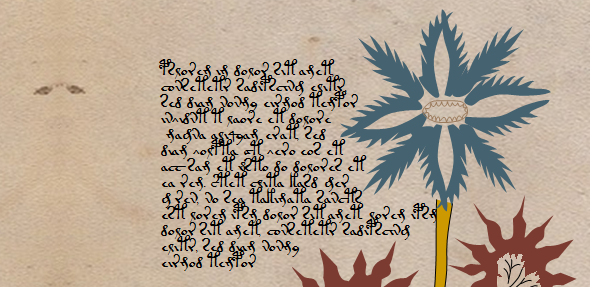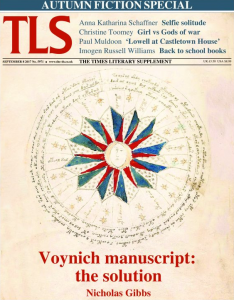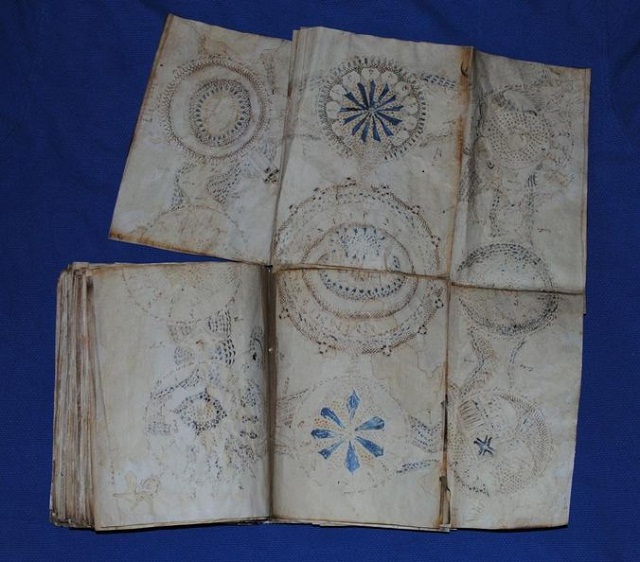Meanwhile over 50 scholars have claimed to have solved the Voynich Manuscript. The latest alleged solution was published earlier this week in a renowned literature magazine. Does it make sense?
The Kennedy murder and the Voynich Manuscript have one thing in common – both have been “solved” dozens of times by hobby researchers and investigators. However, while “solving” the Kennedy murder seems to have gone a little out of style, still one Voynich Manuscript solution is chasing the other. So far, I have introduced only three of these on my blog. It would be no problem to list 50 of them.
Yet another solution
A few days ago, another alleged Voynich Manuscript solution was published (thanks to Sven Rudloff, Tobias Schrödel, Eberhard Bauer, Stefan Fendt, Knut Junker, and Dr. Ralf Bülow for the hints). This time, the new theory is not the work of a hobby scientist, who has made available his findings on a private website. In fact, Nicholas Gibbs, who discovered this solution, is a professional history researcher. He has published his theory in a leading British literature magazine, which is closely tied to one of the most renowned newspapers in the world – the Times Literary Supplement. Apparently, Gibbs’ Voynich Manuscript solution is even the title story of the current issue.
On the one hand, never has a Voynich Manuscript solution been published in such a prominent magazine. On the other hand, no scientific magazine with peer review (such as the Cryptologia) has reported on this story. As long as no publication of this kind has accepted Gibbs’ findings, I remain skeptical.
Gibb’s article tells us a lot about bathing, medicine and herbariums in the Middle Ages. However, the actual solution is not explained in detail. According to Gibbs, the Voynich Manuscript is written in an abbreviated Latin with every letter standing for a word.
Apparently the following figure Gibbs calls the “diagram of nine illustrated spheres” played a key role in breaking the Voynich Manuscript code:
Though Gibbs writes a few lines about the alleged meaning of this diagram, it doesn’t become clear to me how he derived his alleged Voynich Manuscript solution from it.
There’s not much more of cryptographical interest I can find in the TLS article. Announcing a solution to one of the world’s most spectaccular mystery and then giving so little information is not necessarily what I call quality journalism.
It can be said that Gibbs’ alleged solution is one of the less spectacular ones. Other Voynich solvers believe that the manuscript was written in some old or lost language or that it was encrypted in a peculiar way. Still others even believe that the Voynich manuscript was written by extraterrestrials. None of these claim has ever been accepted by the Voynich experts.
Reactions
Gibbs’ Voynich Manuscript theory has received a lot of attention in the Voynich scene. Almost all expert comments I have seen so far are negative. For instance, Nick Pelling included the following statement in a blog post titled What’s wrong with today’s Voynich theory?:
I could list a whole load of things that are wrong with this [solution], but I’d be typing all night on a TL;DR post and nobody would care. *sigh*
Most reactions on the Voynich Manuscript mailing list were negative, as well. Richard SantaColoma, another Voynich Manuscript expert and reader of this blog, posted a long list of “red flags” that make Gibbs’ solution suspicious. For instance, he wrote:
Author writes, “The foldout diagram of nine illustrated spheres found in the Voynich manuscript proved the key to understanding it… …The design, in spite of its Persian influence, is definitely Mediterranean in style and content.”
“Definitely”? Anyway, they note different influences here, but then, they stop. The Voynich shows reasonable comparisons to dozens of regions, cultures, styles, eras… but here we have two picked. In his work, he cherry picks several, which suit the theory, and ignores all the very many others.
As a reply to Richard’s comment, Julian Bunn wrote:
Nice analysis, Rich! You picked up on most of the things that jumped out at me, too. It does sound like he came up with this “solution” in isolation from the VMS community, and so had no peer review to help him get an idea of how much sense he was making. Why the press pick up these things from left field baffles me – and they make such a splash about them!
For those who speak German: Dr. Jürgen Hermes, another Voynich Manuscript expert and reader of this blog, wrote the following comment on Google+:
Die Theorie stützt sich ausschließlich auf die Illustrationen des Manuskripts und lässt die Besonderheiten des Textes (Entropie, Funktionale Zeileneinheiten, Wortbildungen) völlig außer acht. Es würde mich wundern, wenn man mit der vorgeschlagenen Methode mehr als fünf Zeilen findet, bei der eine Übersetzung passt. Aber um das wirklich auszuschließen, muss der Herr erst einmal mit Einzelheiten rausrücken.
I am of a similar opinion as almost all other Voynich Manuscript experts that published statements about this alleged solution. I am very skeptical, but don’t want to make a final judgement before Nicholas Gibbs has made availabe a detailed description of his alleged solution.
I wonder why such a renowned magazine as the Times Literary Supplement has published such a speculative article with so little content with the title “The Voynich manuscript: the solution”. Naming it “A New Voynich Manuscript Theory” would have been a lot more appropriate.
As frequent readers of this blog know, I recently published a test that helps to confirm the validity of alleged Voynich Manuscript solutions. I recommend Gibbs to take this test.
Follow @KlausSchmeh
Further reading: Voynich manuscript: 898 official replicas and one unofficial one
Linkedin: https://www.linkedin.com/groups/13501820
Facebook: https://www.facebook.com/groups/763282653806483/





Kommentare (19)